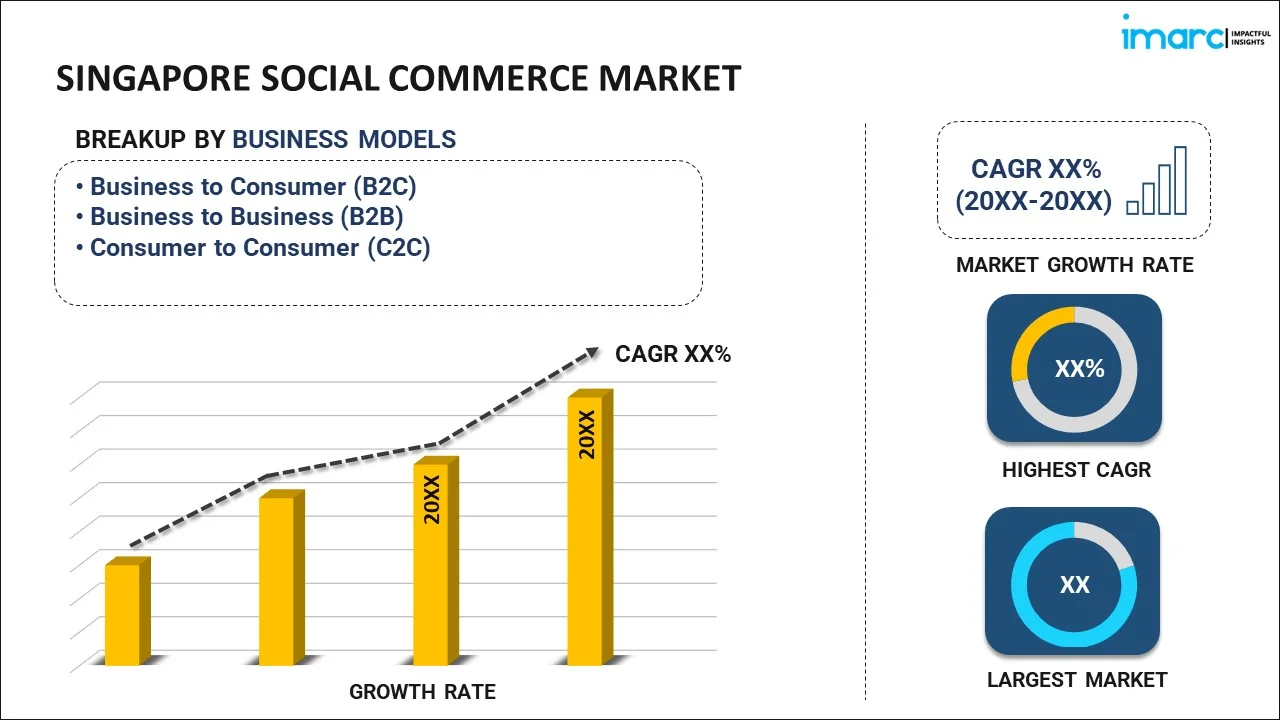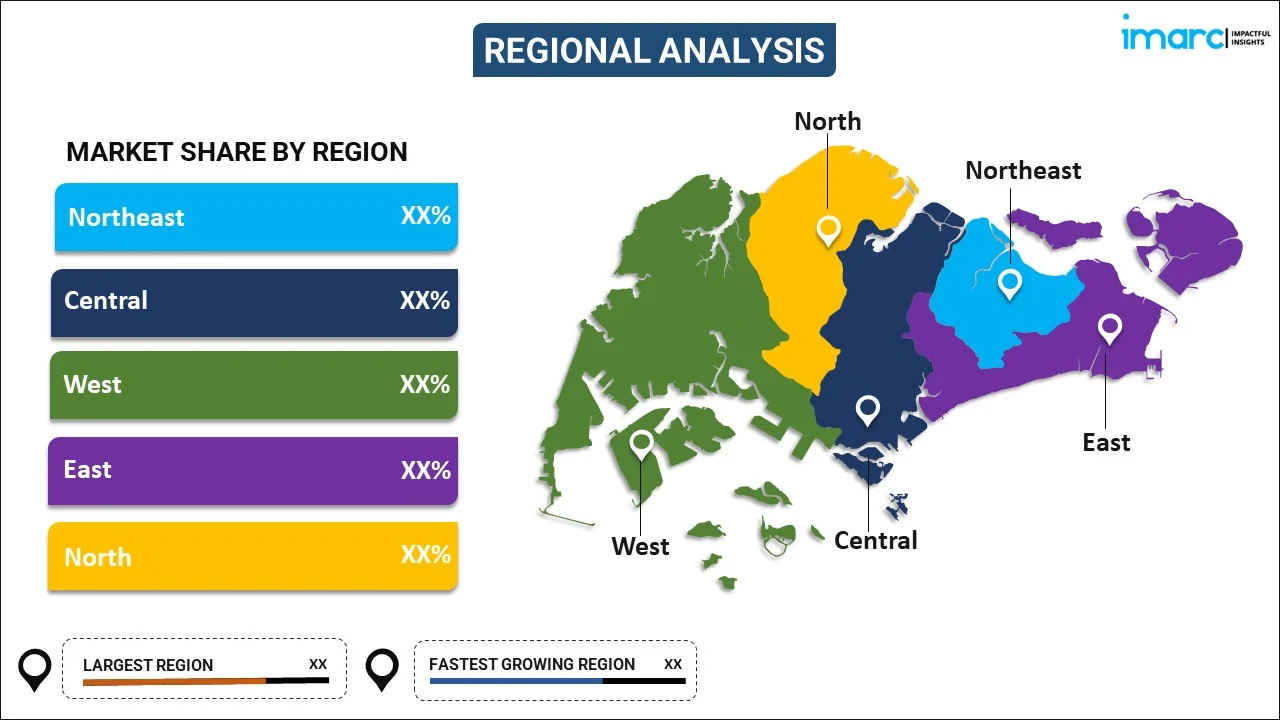
Singapore Social Commerce Market Report by Business Model (Business to Consumer (B2C), Business to Business (B2B), Consumer to Consumer (C2C)), Device Type (Laptops and Pcs, Mobiles), Product Type (Personal and Beauty Care, Apparel, Accessories, Home Products, Health Supplements, Food and Beverages, and Others), Region 2025-2033
Singapore Social Commerce Market Overview:
The Singapore social commerce market is projected to exhibit a growth rate (CAGR) of 17.50% during 2025-2033. Increased advancements in technological solutions and internet penetration, the growing use of smartphones among the masses, and increasing implementation of favorable regulatory policies are some of the factors contributing to the growth of the market.
|
Report Attribute
|
Key Statistics
|
|---|---|
|
Base Year
|
2024 |
|
Forecast Years
|
2025-2033
|
|
Historical Years
|
2019-2024
|
| Market Growth Rate (2025-2033) | 17.50% |
Singapore Social Commerce Market Trends:
Technological Advancements and Internet Penetration
According to the information provided by Commission factory in 2023, the number of social media users is projected to climb 5.4 million in 2023. The expansion of the social commerce market in Singapore has been greatly impacted by the widespread use of mobile technologies and high-speed internet. Due to the increased rate of internet penetration, social media sites, where social commerce is thriving, are easily accessible to people. The user experience is being improved by advanced technology, such as 4G and 5G networks, which enable quicker loading times and improved multimedia content engagement. More time is being spent on social media platforms as a result of their improved usability and convenience of access. Businesses can use these platforms to interact with prospective clients by using direct sales channels and targeted advertising.
Furthermore, as most internet users access social media through mobile devices, the growth of mobile commerce enhances social commerce.
Influencer Marketing and User-Generated Content
In Singapore, influencer marketing is starting to take center stage in social commerce. Influencers can reach and interact with big audiences by using their personal brand and credibility to endorse products and services. These can range from celebrities to micro-influencers. Recommendations from influencers they follow are becoming more trusted by the public, who consider these endorsements to be more genuine than traditional advertising. Because their favorite influencers are trusted, followers are more likely to buy things that they recommend, and this results in increased conversion rates.
Moreover, user-generated content (UGC) is essential to the growth of social commerce. People use social media platforms to actively share their experiences, opinions, and suggestions, which results in an abundance of real content that might affect people's decisions to buy. By using branded hashtags, holding competitions, and reposting user content, brands encourage the public to share their experiences. In addition to increasing brand awareness, this organic promotion helps customers feel more connected to the brand and more trustworthy.
Government Support and Regulatory Environment
The expansion of the social commerce market in Singapore is facilitated by the government's initiatives and the legal environment. The government of Singapore has persistently advocated for digital transformation in a range of areas, acknowledging the potential of social and e-commerce to propel economic expansion. Small and medium-sized businesses (SMEs) can increase their competitiveness and reach by using digital technologies, such as social commerce platforms, with the support of initiatives like the SMEs Go Digital program.
Moreover, Singapore's regulatory system offers an atmosphere that is reliable and safe for online transactions. Strong data protection regulations, such the Personal Data Protection Act (PDPA), guarantee that user data is treated with the highest care, increasing consumer trust in online retailers. Furthermore, the government's initiatives to strengthen cybersecurity and digital infrastructure contribute to the development of a trustworthy and safe online marketplace.
Singapore Social Commerce Market News:
April 2024: Loyalty e-commerce aggregator Presto announced its expansion into Singapore and Thailand via partnerships with Bonis Link and Touch ‘N Go eWallet.
Singapore Social Commerce Market Segmentation:
IMARC Group provides an analysis of the key trends in each segment of the market, along with forecasts at the country level for 2025-2033. Our report has categorized the market based on business model, device type, and product type.
Business Model Insights:

- Business to Consumer (B2C)
- Business to Business (B2B)
- Consumer to Consumer (C2C)
The report has provided a detailed breakup and analysis of the market based on the business model. This includes business to consumer (B2C), business to business (B2B), and consumer to consumer (C2C).
Device Type Insights:
- Laptops and PCs
- Mobiles
A detailed breakup and analysis of the market based on the device type have also been provided in the report. This includes laptops and PCs, and mobiles.
Product Type Insights:
- Personal and Beauty Care
- Apparel
- Accessories
- Home Products
- Health Supplements
- Food and Beverages
- Others
The report has provided a detailed breakup and analysis of the market based on the product type. This includes personal and beauty care, apparel, accessories, home products, health supplements, food and beverages, and others.
Regional Insights:

- North-East
- Central
- West
- East
- North
The report has also provided a comprehensive analysis of all the major regional markets, which include North-East, Central, West, East, and North.
Competitive Landscape:
The market research report has also provided a comprehensive analysis of the competitive landscape. Competitive analysis such as market structure, key player positioning, top winning strategies, competitive dashboard, and company evaluation quadrant has been covered in the report. Also, detailed profiles of all major companies have been provided.
Singapore Social Commerce Market Report Coverage:
| Report Features | Details |
|---|---|
| Base Year of the Analysis | 2024 |
| Historical Period | 2019-2024 |
| Forecast Period | 2025-2033 |
| Units | Billion US$ |
| Scope of the Report | Exploration of Historical Trends and Market Outlook, Industry Catalysts and Challenges, Segment-Wise Historical and Future Market Assessment:
|
| Business Models Covered | Business to Consumer (B2C), Business to Business (B2B), Consumer to Consumer (C2C) |
| Device Types Covered | Laptops and Pcs, Mobiles |
| Product Types Covered | Personal and Beauty Care, Apparel, Accessories, Home Products, Health Supplements, Food and Beverages, Others |
| Regions Covered | North-East, Central, West, East, North |
| Customization Scope | 10% Free Customization |
| Post-Sale Analyst Support | 10-12 Weeks |
| Delivery Format | PDF and Excel through Email (We can also provide the editable version of the report in PPT/Word format on special request) |
Key Questions Answered in This Report:
- How has the Singapore social commerce market performed so far and how will it perform in the coming years?
- What has been the impact of COVID-19 on the Singapore social commerce market?
- What is the breakup of the Singapore social commerce market on the basis of business model?
- What is the breakup of the Singapore social commerce market on the basis of device type?
- What is the breakup of the Singapore social commerce market on the basis of product type?
- What are the various stages in the value chain of the Singapore social commerce market?
- What are the key driving factors and challenges in the Singapore social commerce?
- What is the structure of the Singapore social commerce market and who are the key players?
- What is the degree of competition in the Singapore social commerce market?
Key Benefits for Stakeholders:
- IMARC’s industry report offers a comprehensive quantitative analysis of various market segments, historical and current market trends, market forecasts, and dynamics of the Singapore social commerce market from 2019-2033.
- The research report provides the latest information on the market drivers, challenges, and opportunities in the Singapore social commerce market.
- Porter's five forces analysis assist stakeholders in assessing the impact of new entrants, competitive rivalry, supplier power, buyer power, and the threat of substitution. It helps stakeholders to analyze the level of competition within the Singapore social commerce industry and its attractiveness.
- Competitive landscape allows stakeholders to understand their competitive environment and provides an insight into the current positions of key players in the market.
Need more help?
- Speak to our experienced analysts for insights on the current market scenarios.
- Include additional segments and countries to customize the report as per your requirement.
- Gain an unparalleled competitive advantage in your domain by understanding how to utilize the report and positively impacting your operations and revenue.
- For further assistance, please connect with our analysts.
 Inquire Before Buying
Inquire Before Buying
 Speak to an Analyst
Speak to an Analyst
 Request Brochure
Request Brochure
 Request Customization
Request Customization




.webp)




.webp)












